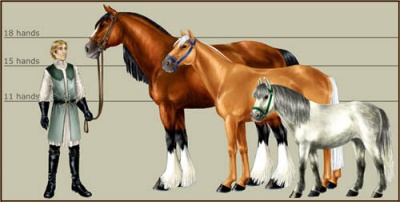No edit summary |
m (The LinkTitles extension automatically added links to existing pages (<a target="_blank" rel="nofollow noreferrer noopener" class="external free" href="https://github.com/bovender/LinkTitles">https://github.com/bovender/LinkTitles</a>).) |
||
| Line 8: | Line 8: | ||
Prices for white [white], black [rapp(oily black)] or grey [spotted grey] horses are *3, or up to *10 for perfect examples | Prices for white [white], black [rapp(oily black)] or grey [spotted grey] horses are *3, or up to *10 for perfect examples | ||
Rules for Horses | [[Rules for Horses]] | ||
== Horse sizes == | == Horse sizes == | ||
Latest revision as of 08:09, 19 October 2017
Horses

Nothing is more important to the knight than his horse. A common saying amongst some knights is “I can always find another wife, a good horse is expensive!”. Since breeding is not commonly known, there are hundreds of shapes, sizes and variations of colors, but for simplicity, here are the common types of horse you will find in these periods.
Horses come in many colors with bay being the most common by far. Other colors can be up to twice or three times as expensive: dun [brown with black mane], chestnut [fux(reddish brown)], roan [constansgrey], buckskin [yellowbrownish] or sorrel [fux]. Prices for white [white], black [rapp(oily black)] or grey [spotted grey] horses are *3, or up to *10 for perfect examples
Horse sizes
Horse size vary a lot, but are mostly small by modern comparison. The greatest horses are around 16-18 hands tall, a normal riding horse around 15. And a cart-horse or donkey around 10-12 hands. See chart.
Types of horses
, , , , , ,
